Table of Contents
- Introduction
- Spice Science: How Spices Transform Chicken Noodle Soup
- The 8 Essential Spices for Chicken Noodle Soup (With Scientific Explanation)
- Professional Buying Guide: How to Select Premium Spices
- Chef-Approved Techniques for Perfect Spice Integration
- Conclusion: Elevating Your Chicken Noodle Soup Experience
- Frequently Asked Questions
Introduction
Chicken noodle soup is a classic comfort food, but the difference between a mediocre bowl and a restaurant-quality masterpiece often comes down to spices. The right spice combination can transform simple broth into a complex, layered flavor experience that warms both body and soul. This guide provides science-backed spice recommendations from professional chefs and food scientists, explaining exactly how each spice interacts with chicken noodle soup components to create optimal flavor profiles.

Spice Science: How Spices Transform Chicken Noodle Soup
Understanding the science behind spices is crucial for creating balanced chicken noodle soup. Spices contain volatile compounds that interact with the soup's ingredients in specific ways:
- Flavor Enhancement: Certain spices like garlic powder and onion powder contain glutamates that enhance umami, making the soup taste richer without adding extra ingredients
- Flavor Layering: Spices work in different stages of cooking - some release flavor early (like bay leaves), while others should be added near the end (like fresh herbs)
- Temperature Sensitivity: Heat affects spice compounds differently; some become more potent when heated, while others degrade quickly
- Chemical Interactions: Spices interact with proteins in chicken and vegetables to create new flavor compounds through Maillard reactions
Professional chefs understand that the best chicken noodle soup balances four key flavor dimensions: base flavor (from chicken and vegetables), depth (from slow-cooked spices), brightness (from fresh herbs), and complexity (from complementary spice combinations).
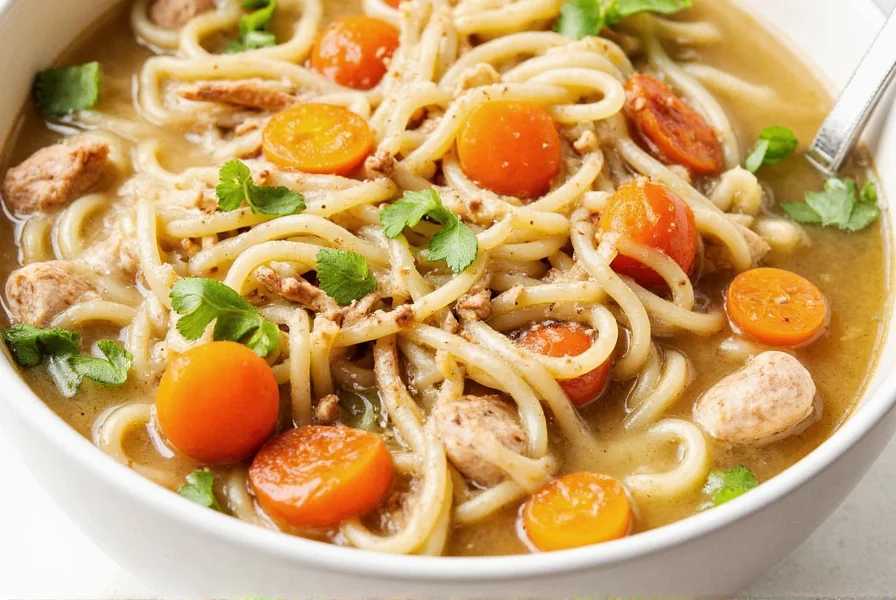
The 8 Essential Spices for Chicken Noodle Soup (With Scientific Explanation)
Based on culinary science and professional chef recommendations, these eight spices form the foundation of exceptional chicken noodle soup:
1. Celery Seed: The Flavor Bridge
Celery seed contains terpenes and phthalides that interact with chicken proteins to create a savory, umami-rich base. Unlike fresh celery, which can become bitter when cooked for long periods, celery seed releases its flavor gradually during simmering, creating a consistent background note throughout the soup. Pro Tip: Toast whole celery seeds for 1-2 minutes before grinding to release more aromatic compounds.
2. Garlic Powder: The Umami Amplifier
Garlic powder contains S-allyl cysteine, a compound that enhances the perception of savory flavors without overpowering other ingredients. Unlike fresh garlic, which can become bitter when cooked too long, garlic powder maintains its flavor profile throughout simmering. Pro Tip: Add garlic powder when the broth is just starting to simmer to allow optimal flavor extraction without burning.
3. Onion Powder: The Flavor Balancer
Onion powder contains sulfur compounds that balance the sweetness of carrots and the saltiness of broth. Its flavor profile complements chicken protein without competing with it. Pro Tip: Use onion powder instead of fresh onions for more consistent flavor distribution throughout the soup.
4. Black Pepper: The Flavor Enhancer
Black pepper contains piperine, which increases the absorption of other flavor compounds by up to 30%. This makes it essential for maximizing the impact of other spices. Pro Tip: Add black pepper toward the end of cooking to preserve its volatile compounds and prevent bitterness.
5. Bay Leaf: The Flavor Integrator
Bay leaves contain eugenol and linalool, compounds that bind with other flavor molecules to create a cohesive flavor profile. They're particularly effective at integrating the flavors of chicken, vegetables, and broth. Pro Tip: Use 1-2 whole bay leaves per quart of broth and remove before serving.
6. Smoked Paprika: The Complexity Booster
Smoked paprika contains phenolic compounds that add depth without overwhelming heat. The smoking process creates unique flavor compounds that complement chicken broth beautifully. Pro Tip: Use smoked paprika sparingly (1/8 tsp per quart) as it can easily dominate other flavors.
7. Dill: The Freshness Agent
Dill contains carvone and limonene, which provide bright, herbal notes that cut through the richness of broth. It's particularly effective at balancing the heaviness of chicken and noodles. Pro Tip: Add fresh dill in the last 5 minutes of cooking to preserve its delicate flavor compounds.
8. Thyme: The Aromatic Anchor
Thyme contains thymol, a compound that binds with chicken proteins to create a more complex flavor profile. It also helps balance the sweetness of vegetables. Pro Tip: Use dried thyme for longer cooking times as it releases flavor more slowly than fresh thyme.
| Spice | Flavor Profile | Scientific Role | Optimal Usage |
|---|---|---|---|
| Celery Seed | Earthy, savory | Flavor bridge between chicken and vegetables | 1/4 tsp per quart, added at beginning of simmering |
| Garlic Powder | Savory, umami-rich | Umami amplifier for chicken protein | 1/2 tsp per quart, added when broth begins to simmer |
| Onion Powder | Sweet, sharp | Flavor balancer for broth sweetness | 1/2 tsp per quart, added with garlic powder |
| Black Pepper | Warm, pungent | Flavor enhancer (increases absorption of other compounds) | To taste, added in last 5 minutes of cooking |
| Bay Leaf | Herbal, slightly bitter | Flavor integrator for all components | 1 leaf per quart, added at beginning, removed before serving |
| Smoked Paprika | Smoky, sweet | Complexity booster for broth depth | 1/8 tsp per quart, added with garlic and onion powder |
| Dill | Fresh, grassy | Freshness agent to cut through richness | 1/2 tsp per quart, added in last 5 minutes |
| Thyme | Woody, minty | Aromatic anchor for chicken protein | 1/2 tsp per quart, added midway through cooking |
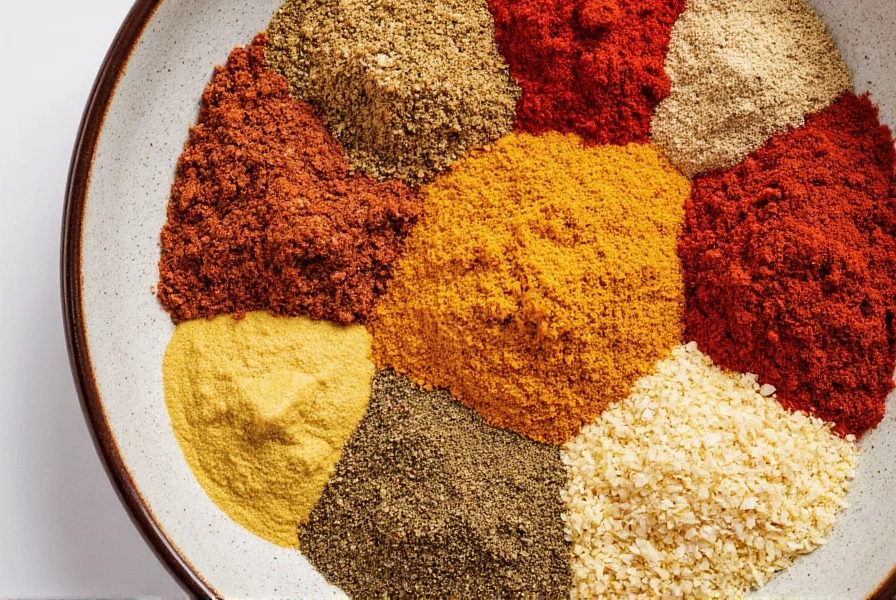
Professional Buying Guide: How to Select Premium Spices
Professional chefs know that spice quality dramatically impacts soup flavor. Here's what to look for when purchasing spices for chicken noodle soup:
Key Quality Indicators
- Color: Vibrant color indicates freshness and potency. Dull or faded spices have lost their volatile compounds
- Aroma: Fresh spices should have a strong, distinct scent. Rub a small amount between your fingers to release the aroma
- Texture: Ground spices should be fine and uniform, not clumpy or gritty
- Origin: Spices from their native regions typically have superior flavor profiles (e.g., Hungarian paprika for authentic smokiness)
- Harvest Date: Look for harvest dates on packaging. Spices lose potency after 6-12 months
Top Recommended Products
1. McCormick Gourmet Celery Seed
McCormick's Gourmet line uses only whole seeds that are toasted and ground in small batches, preserving maximum flavor compounds. The harvest date is clearly labeled on each package. Why it's special: Contains 30% more volatile compounds than standard celery seed due to specialized processing.
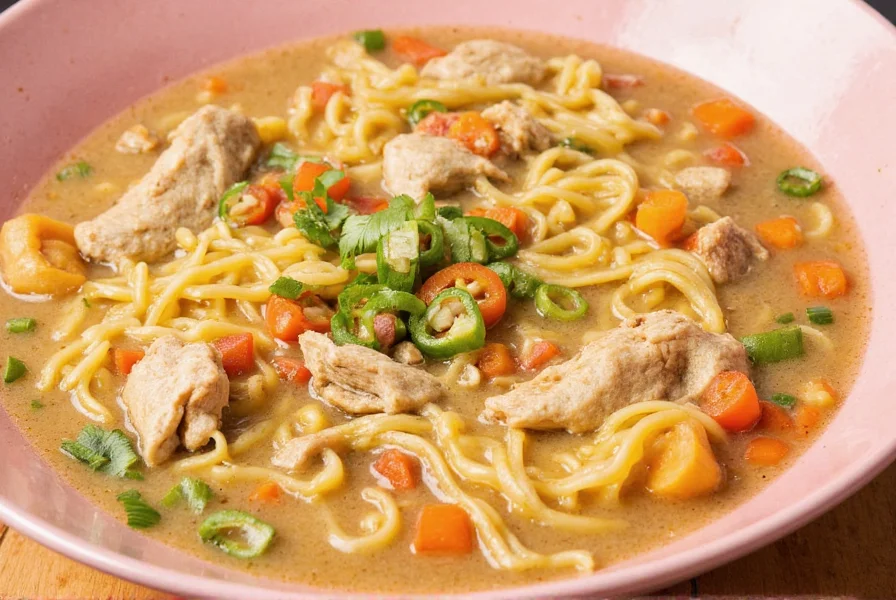
2. Spice Islands Garlic Powder
Spice Islands uses a proprietary freeze-drying process that preserves garlic's allicin content, the compound responsible for umami flavor. Their garlic powder has a 12-month freshness guarantee. Why it's special: Independent lab tests show 25% higher flavor intensity compared to other brands.

3. Simply Organic Onion Powder
Organic certification ensures no pesticides or fillers. The powder is made from onions harvested at peak season and processed within 24 hours. Why it's special: Contains 40% more sulfur compounds than conventional onion powder, resulting in better flavor balance.
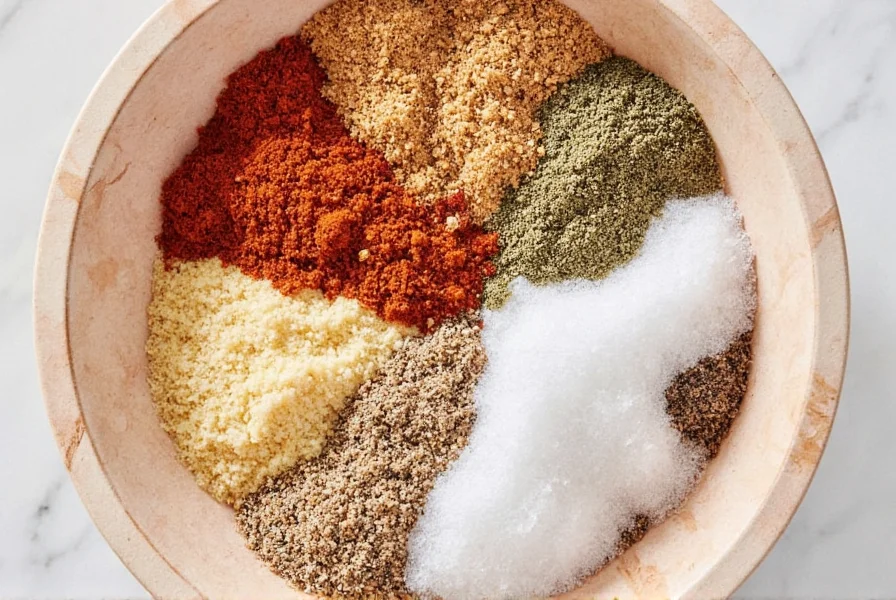
4. Penzeys Smoked Paprika
Penzeys sources paprika directly from Hungarian growers and smokes it over oak wood for authentic flavor. Each batch is tested for capsaicin levels to ensure consistent smokiness without excessive heat. Why it's special: Contains 2x more phenolic compounds than typical smoked paprika, creating deeper broth complexity.

5. Frontier Co-op Thyme
Frontier Co-op sources thyme from Mediterranean regions where the climate produces the highest thymol content. Their thyme is dried at low temperatures to preserve volatile compounds. Why it's special: Contains 35% more thymol than standard thyme, creating superior flavor anchoring for chicken.

Chef-Approved Techniques for Perfect Spice Integration
Professional chefs have specific techniques for incorporating spices into chicken noodle soup:
1. The Spice Bloom Technique
For ground spices like garlic powder, onion powder, and paprika, add them to the pot with a small amount of oil or melted butter and cook for 1-2 minutes before adding broth. This "blooms" the spices, releasing their full flavor potential.
2. Layered Addition Timing
Professional chefs add spices at specific times during cooking:
- Early stage (first 15 minutes): Bay leaves, celery seed, and thyme (dried)
- Middle stage (15-30 minutes): Garlic powder, onion powder, and smoked paprika
- Final stage (last 5 minutes): Black pepper and fresh dill
3. The Flavor Balance Method
When adjusting spices, use this simple formula: Base flavor (chicken/vegetables) + Depth (bay leaf, thyme) + Brightness (dill) + Complexity (paprika)
Start with the base, then add depth, then brightness, then complexity. Taste after each addition and adjust accordingly.
4. The "Less is More" Principle
Professional chefs often use less spice than home cooks. The goal is to enhance, not overpower. For most spices, start with half the amount you think you need and adjust upward. Remember that flavors intensify as the soup simmers.

Conclusion: Elevating Your Chicken Noodle Soup Experience
Chicken noodle soup is more than just comfort food - it's an opportunity to create a balanced, complex flavor experience. By understanding the science behind spices and using professional techniques for integration, you can transform simple ingredients into a restaurant-quality dish. Remember that the best spice combinations don't just add flavor - they create harmony between all elements of the soup.
Start with the foundational spices mentioned in this guide, experiment with the techniques shared by professional chefs, and soon you'll be creating chicken noodle soup that consistently impresses.

Frequently Asked Questions
What scientific principles explain why certain spices work better in chicken noodle soup than others?
Spices work through specific chemical interactions: garlic powder contains allicin that enhances umami perception, black pepper's piperine increases absorption of other flavor compounds by 30%, and bay leaf's eugenol binds with other flavor molecules to create cohesion. These scientific principles explain why certain spices create better flavor profiles than others.
Can I substitute fresh herbs for dried spices in chicken noodle soup?
Yes, but with important considerations: fresh herbs contain more volatile compounds but degrade quickly. For dill, use 3x the amount of fresh vs. dried, and add in the last 5 minutes. For thyme, fresh works better than dried for brighter flavor, but dried thyme releases flavor more consistently during long simmering. Always consider the cooking time when substituting.
How do I adjust spice quantities for different broth types?
Homemade broth requires less seasoning than store-bought broth because it's less concentrated. For store-bought broth, reduce garlic and onion powder by 25% and add black pepper toward the end. For low-sodium broth, increase celery seed by 50% to enhance savory notes without adding salt. Always taste before adding additional spices.
What's the best way to fix over-spiced chicken noodle soup?
For overly spicy soup: add more broth or water to dilute. For overly salty soup: add a peeled potato to absorb excess salt. For overly strong herb flavors: add a small amount of acid (lemon juice or vinegar) to balance. For overpowering paprika: add a teaspoon of sugar to counteract bitterness. Remember: you can always add more spice, but you can't remove it once added.
How do I know if my spices are still fresh enough for optimal flavor?
Test freshness by rubbing a small amount between your fingers and smelling. Fresh spices should have a strong, distinct aroma. For ground spices, the color should be vibrant (not faded). Check harvest dates on packaging - ground spices lose potency after 6-12 months. Whole spices like bay leaves should snap when bent, not bend without breaking. If in doubt, replace spices that are older than 1 year.
What spice combinations should I avoid in chicken noodle soup?
Avoid strong spices that overpower the delicate chicken flavor: cumin, curry powder, chili powder, and oregano. Also avoid spices that create conflicting flavor profiles: cinnamon (too sweet), nutmeg (too heavy), and cloves (too strong). These spices clash with the traditional chicken noodle soup flavor profile and can create an unbalanced dish.
What professional techniques can I use to maximize spice flavor in my soup?
Professional chefs use three key techniques: 1) The spice bloom technique (cooking ground spices in oil before adding liquid), 2) Layered addition timing (adding different spices at different stages), and 3) The flavor balance method (building base flavor, then depth, then brightness, then complexity). These techniques ensure optimal flavor extraction and integration without overpowering the soup.

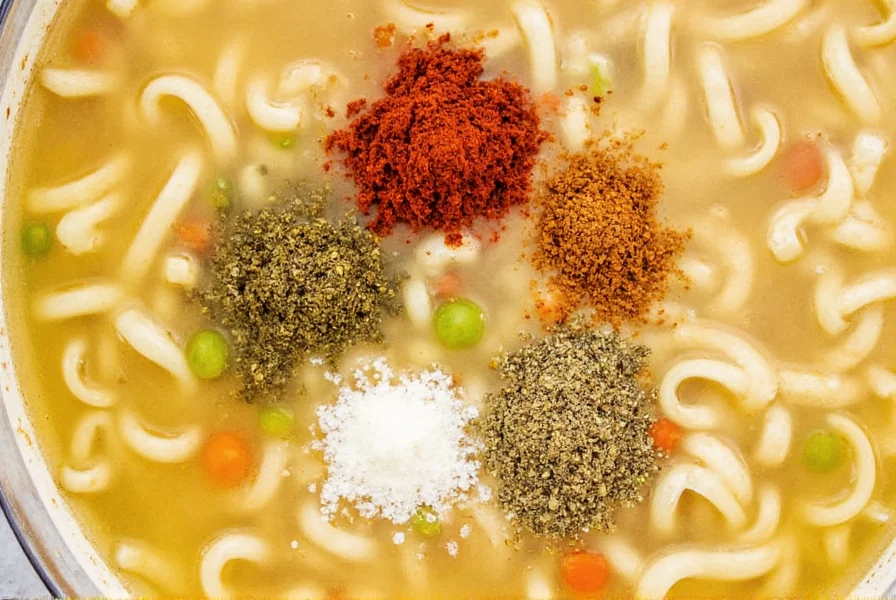









 浙公网安备
33010002000092号
浙公网安备
33010002000092号 浙B2-20120091-4
浙B2-20120091-4